Your First Day
After the daily briefing at 9.00am our staff will introduce
you to our operation, facilities and some rules which are described on this
page. We
will complete all paperwork that is necessary for you to fly legally in Narromine.
If this is your first stay with us, or you have not flown with us
currently, we will be flying with you in one of our double-seaters
first. This will help you to familiarize and get used to Narromine and
our area. Once you are checked out you can 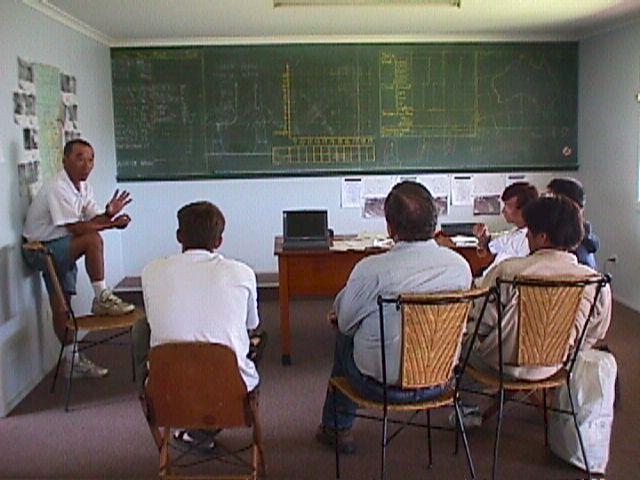 proceed to your
single-seater and enjoy our magnificent conditions on your own. proceed to your
single-seater and enjoy our magnificent conditions on your own.
Launching:
Launching begins at about 11.00 am depending on the weather and each pilot‘s needs.
Get your glider ready and take away all the towing gear before we commence with launching.
After your Landing:
After your final landing our staff will pick you up and bring you and your glider to the
hangar.
Back in the hangar clean your glider, return battery, maintenance release.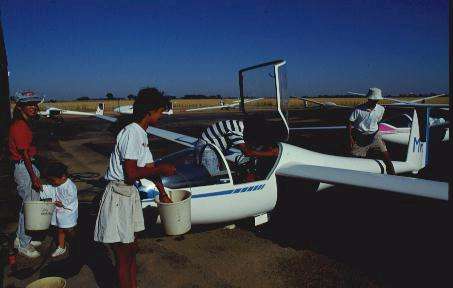
A Typical Flight:
Take-off and Aerotow
ABCD and CHAOTIC before
take-off:
Pre-boarding
A AIRFRAME (walk around check for damage and/or defects. Maintenance release checked,
including DI validity).
B BALLAST (glider loading is within placarded limitations and trim ballast, if required, secure).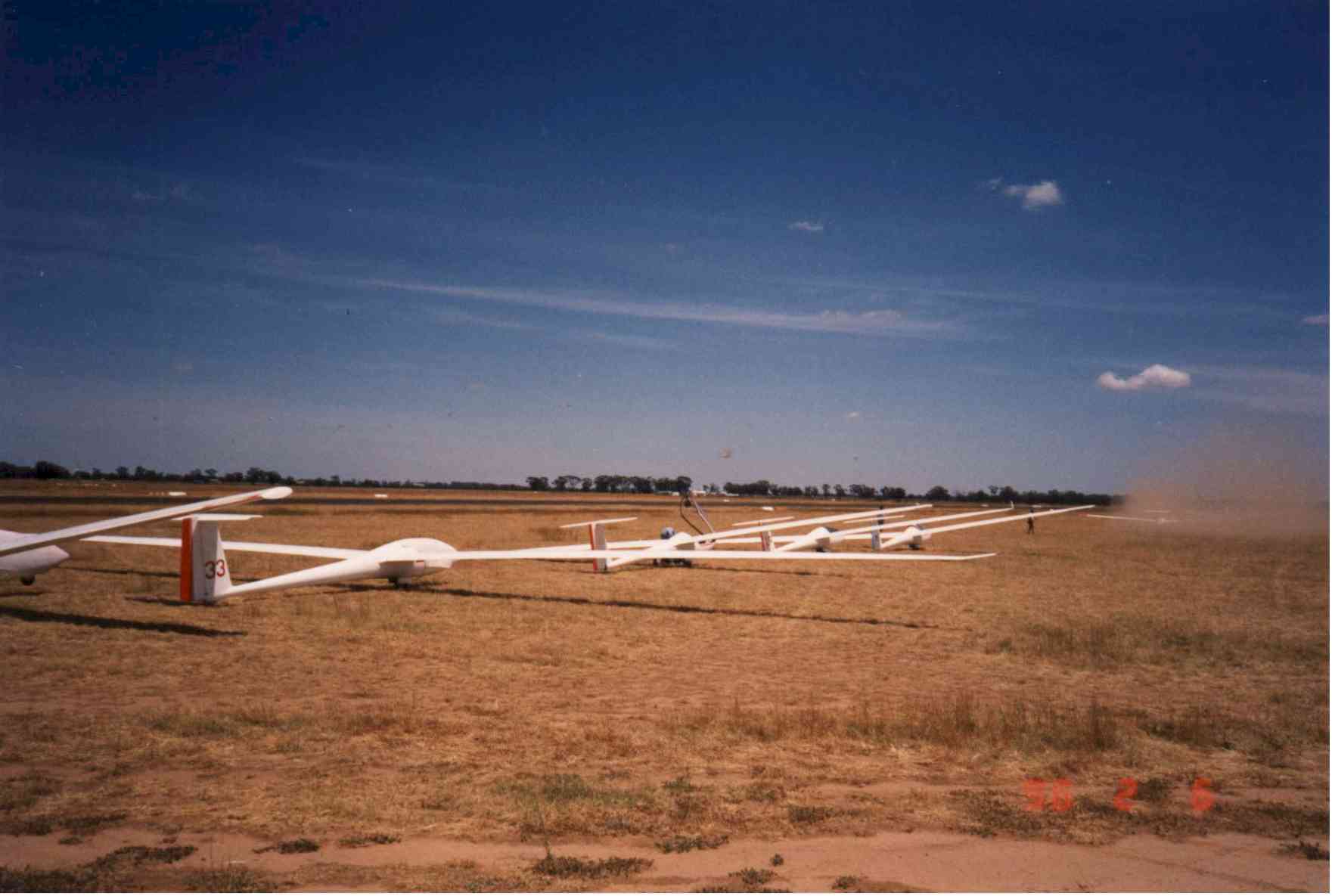
C CONTROLS (check controls, including airbrakes and flaps, for correct sense and full deflections).
D DOLLIES (all dollies and ground handling equipment removed).
Post-boarding
C CONTROL ACCESS
(Seat adjustments secure and positioned to allow for comfortable access
to all flight controls, panel switches/knobs and the tow release.
Rudder pedals adjusted for reach if applicable).
H HARNESS (secure, lap belt low on hips, both pilots),
A AIRBRAKES and FLAPS (airbrakes cycled and set for launch, or closed and locked. Flaps set),
O OUTSIDE (airspace and take-off path clear. Wind velocity checked. Sufficient competent ground
crew available).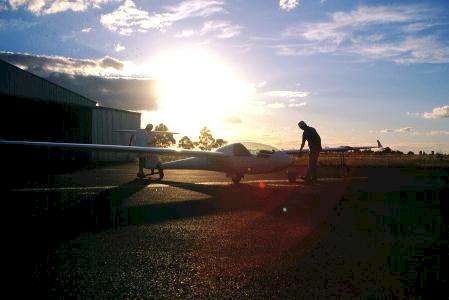
OPTIONS (evaluate emergency plan in case of launch failure).
T TRIM (ballast confirmed. Trim set as required)
I INSTRUMENTS (altimeter set, other instruments reading normally, no apparent damage. Radio on and correct frequency)
C CANOPY (closed, locked and clean)
CARRIAGE (undercarriage locked down)
CONTROLS (checked for full and free movement)
Once you have completed CHAOTIC we will hook on the towrope and do a release
check once a day
before the first flight.
When you are ready for take-off put up your thumb.
After the ground crew has confirmed "AIR SPACE CLEAR" your wings will
be levelled
for take-off. Before take-off the tug pilot may request a radio check from you.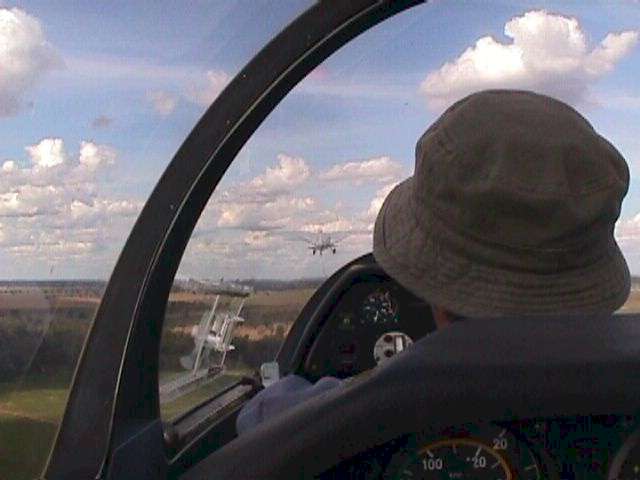
Towing
As many different nationalities are flying together at our soaring centre we do
not insist
on low tows which are common in Australia and many other soaring centres.
Whatever
towing method you are used to, and which ever towing method you prefer, we
ask
you to use.
Release and right turn
You may release at about 2,800ft QNH, however not lower than 2,300ft QNH.
Please make sure before release that the airspace is clear to the right where you are.
FUST after
release:
After release do a right clearing turn away from the tug. During your right turn you should complete
FUST after established climbing.
F – Flaps set as required
U – Undercarriage up and locked
S – Speed set as required
T – Trim set for the selected speed
If a launch failure occurs
Our cables break very seldom and our tugs are very reliable, but nevertheless you must be
ready any time.
* First priority, acquire and maintain the normal pitch down and safe speed near the ground
* Locate your position which of course includes your altitude
* Identify and operate
During your flight:
Narromine has one of the best gliding conditions in the world. Strong thermals with up to
10kts and up to 16,000ft are not seldom. But because we have so strong thermals you can
enter a spin occasionally when you enter or leave a thermal and one of your wings stalls.
This is not dangerous if you have enough altitude and you know how to recover safely. If
you are not confident in how to recover from a spin please ask us for spin recovery
training in one of our double-seaters.
Thermalling speeds
For the Astir IIIb we recommend 45kts. For all other gliders 50kts.
Do not thermal after entering downwind. If you enter downwind or you
have a launch failure you must acquire the safe speed
near
the ground. We recommend the following speeds: Astir IIIb 50kts, Hornet, ASK 21 55 kts, all other gliders 60kts.
Are you keeping a good look-out at all times? Narromine has no airspace restrictions but
you are not flying alone in our skies without limitations. Therefore keep a good
look-out at all times. Use the information which you can receive from your radio
to see others. If you are not sure whether another aircraft can see you, stay away even if
you have the right of way.
As Narromine has so magnificent gliding conditions, it can be quite hot. Temperatures of
up to 40°C can be normal which results in thermals up to 14,000 ft and higher. Therefore
bring enough drinking water with you during your flight. Drink at least every 30 minutes.
Bring only water with you into your cockpit. Sports or other sweet drinks attract insects.
For long flights bring some food with you like eg muesli bars. Start slowly and give
yourself time to get acclimatized.
With thermals usually higher than 10,000ft every day it is hard not to fly too high, but
please keep in mind without oxygen supply you should not stay above 10,000 ft.
Sunsets in Narromine are wonderful. If you observe one sunset you will realize that there
is no twilight and it will be completely dark shortly after sunset. Therefore land before
sunset. If you land just before sunset, choose a landing direction which is not heading
towards the sun.
By the way cloud, flying is not permitted for gliders in Australia.
Radio procedures during flight:
Leaving the CTAF of Narromine
The sizes of Narromine CTAF (Common Traffic Advisory Frequency) are 10nm in radius
(10nm
are about 18km) and between 3,000 ft and 5,000 ft AGL in height.
When you are leaving the CTAF of Narromine transmit on 126.700:
"Callsign [eg UP] LEAVING FREQUENCY".
Afterwards
change your radio to 122.500 and transmit: "Callsign [eg IUL] ON FREQUENCY."
122,500 is a glider frequency, it is used between glider and glider, between glider and
glider base, between glider base and glider base and between glider and tug in case of an
retrieve from an outlanding.
Entering the CTAF of Narromine
Before entering Narromine CTAF transmit on 122.500:
Callsign [eg.33] LEAVING FREQUENCY [eg FOR LANDING IN
NARROMINE]."
Afterwards change your radio to 126,700.
When entering Narromine CTAF make an inbound call:
ALL TRAFFIC NARROMINE, GLIDER, Callsign, [eg 33],
position
which includes your altitude in QNH, [eg 5 NM NORTH WEST OF NARROMINE, 3,000 ft]
INBOUND NARROMINE."
Circuit and landing:
Circuits
All circuits
are left-hand circuits.
Do a right hand circuit only if you feel you cannot complete a left hand circuit safely.
Observe the surface direction and velocity of the wind and decide your landing direction
and runway.
Runways
As runways you can use: 29 grass right, 11 grass left, 22 grass right and 04 grass left.
The asphalt or bitumen runways can be used as a second choice.
Landing
Entry Point Check , FUST&W and Radio Call on 3000QNH above Airfild.
We drink water in this stage for switching mind from soaring to landing
and clearing ear block.
Radio call "All TRAFFIC NARROMINE GLIDER IUP ABOVE NARROMINE 3000F UNDER CARRIAGE DOWN AND LOCKED NARROMINE"
Down wind Check
Plan your circuit with 1,800ft QNH (1,000 ft AGL) at your checkpoint.
2nd FUST before
entering downwind:
F – Flaps set as required
U – Undercarriage down and locked
S – Speed set as required, safe speed near the ground
T – Trim set for the selected speed
Radio call when entering Downwind
"ALL TRAFFIC NARROMINE, GLIDER ‚PI‘, LEFT
DOWNWIND, 04 GRASS LEFT, UNDERCARRIAGE DOWN AND LOCKED NARROMINE."
Landings
Do not land towards an obstacle or another glider and make sure your path is clear.
After touch-down keep taxing straight until you stop, do not taxi out from the runways,
another glider might be just landing beside and behind you.
Flying Cross-Country
Once you are familiarized with your glider and Narromine airfield you begin to go
cross-country. This is the moment when you will enjoy Australia‘s tremendous gliding
heaven most. Cross–country flying around Narromine is easy and safe.
No airspace restrictions or difficult weather patterns. Nevertheless it can happen that you face an out landing.
The following chapter will help you to conduct an out landing as safe as possible. If you
like to practise a real outlanding in one of our double-seaters with one of our
experienced instructors feel free to ask us. A real exercise is of course the best
preparation. Or walk to some paddocks on your own for a closer inspection.
Altitude - Management:
Outlandings are easy if you manage your altitude correctly.
At 2,000ft AGL:
If you descend to 2,000ft AGL you must think of the possibility for an out
landing at the
latest.
Broadcast on your radio on 122,500 if possible: "Callsign,
position including altitude in QNH [eg 10KM SOUTH OF PEAK HILL, 3,200ft] MAY
OUTLAND."
At 1,500 ft
AGL:
If you descend to 1,500ft AGL you must choose a safe paddock at the latest.
Once you have selected a paddock you can try to find a thermal in the gliding ratio of
your selected paddock. Do not try to find a thermal without having selected a paddock
first!
At 1,000 ft
AGL:
If you descend to 1,000ft AGL you must enter downwind, do your FUST check and
make sure you have dumped all your water ballast.
How to select a safe paddock for an outlanding:
SSSSW – Outlanding
Check:
Size: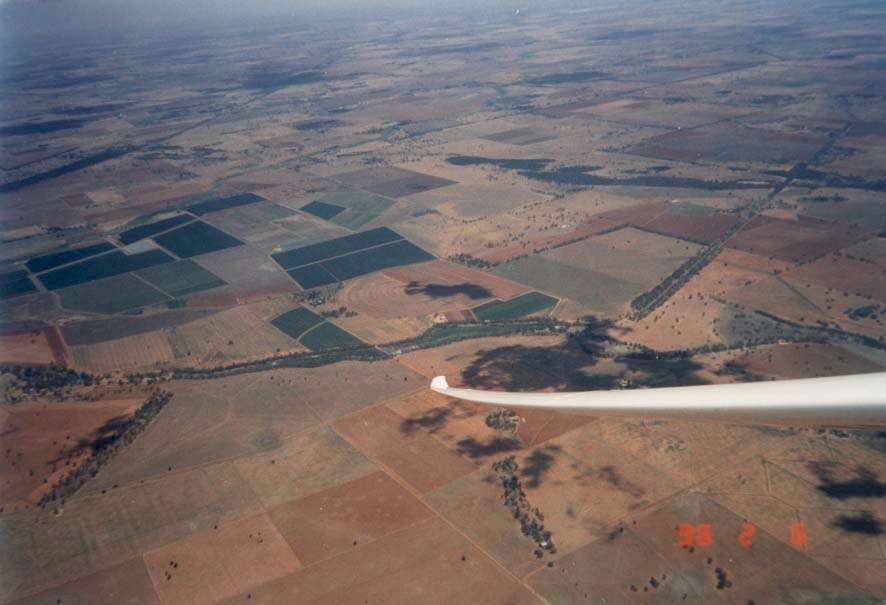
The size of the chosen landing area must be adequate.
If the size of your selected landing paddock is big enough we can land with our tug in
your paddock and tow your glider out.
This is faster than any road retrieve.
Surface:
- First choice: Freshly harvested stubble paddocks. They can be recognized by the wheel marks of the
harvester.
Patterns which the wheel marks from the harvester have left:
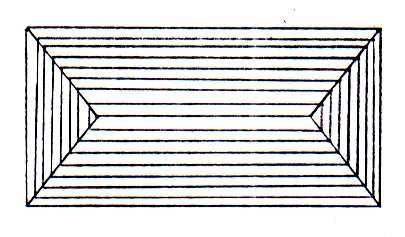 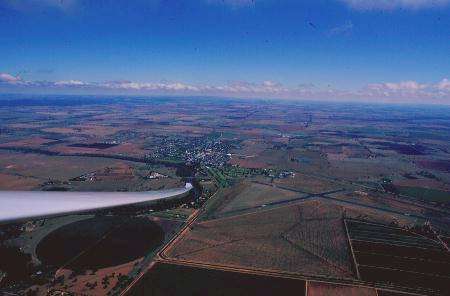
- Second choice: One or two years old
grassy
stubble paddocks.
They can be recognized by harvesting wheel marks partially left.
- Bad choices: Bad choices are ploughed paddocks. They can be used if you cannot find any
other paddocks.
Air-retrieves are not possible and small damage to your glider is very likely. Land only
along the furrows.
- Do not choose: High standing crops, irrigated fields and paddocks with
too many animals, trees or tree stumps, erosion gullies and contour banks as well as
circular paddocks and all paddocks with the following patterns:

Generally land along the furrows or wheel marks of the
harvester even if out of the wind.
Slope:
Choose a paddock without any slope as the area around Narromine has plenty of flat
paddocks.If at all steep, land up the slope.
Surroundings and Stock:
Look for power lines, telephone lines, stock or grazing animals, fences, stones, trees and
tree stumps. Make sure your approach path is clear from any obstacles and you do not land
towards any obstacle.
Fences: Every paddock is surrounded by a fence, usually there are no fences inside a
paddock. Big stones, stumps and small bushes can be found by observing the wheel
marks of
the harvester.
SWER (single wire earth return) lines can be a real hazard as they are difficult to see
and the poles are far apart. If you have enough time to select your outlanding paddock you
will have sufficient time to overfly your paddock and inspect it for SWER lines. Every
house will have at least one power line going to it, try to find it before you land.
Wind:
As usual, plan to land into the wind. You can find out the wind direction from your drift,
from dust, smoke or water holes for grazing animals.
Landing on an airfield:
If you decide to land on a CTAF airfield follow the same procedures as
in Narromine.Land only on the runways.After stopping make sure that the
outside of the runway is accessible and push your glider out of the
runway.
Landing in Dubbo:
Dubbo is a CTAFR (Restricted Common Traffic Advisory Frequency). Not a CTAF. When flying into a
CTAFR and/or
landing in a CTAFR different procedures apply. If you like to know how to fly into a
CTAFR and how to land there
please ask us for details.
After landing:
Try to contact other gliders on 122.500 and inform them that you have outlanded andeverything is okay.
Find out your exact position on the map, inspect your paddock and decide whether you request an air retrieve or a road retrieve.
If you cannot establish radio contact, or you do not know where your
position is, try to find the next farmhouse or telephone. Best is try
to use your Mobile Phone
Before leaving the glider put the canopy cover on, secure theglider with its tie down kit and take your water bottle with you.
MobilePhone numbers: 041 999 2396.
|







